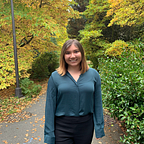Inclusion From the Start (Up)
Seattle is known for many things — including a thriving culture around startups. The amount of work and resources that go into building a startup company is overwhelming. But, by parsing the process of creating a startup, the first thing I need is a great idea. When I think of my own potential startup ideas I know that they aren’t exactly novel. But then, I realized that I can add a new twist on the ideas — like prioritizing accessibility and inclusion as a first step and having that be my guiding compass through the process.
As a start-up enthusiast and avid UX researcher, here are some things I learned:
1. Build an Inclusive Team
Something I live by in my personal life is to surround myself with people who will help me be my best self and who I aspire to be. This should also be reflected in building a team for startups. (Check out these cool quotes by industry leaders who support this!) Through creating a diverse and inclusive team — not only in demographics but also in mindset, such as people who reflect on and understand inclusion as it applies to society — this will set the foundation for a more inclusive culture.
Not only does being inclusive from the start allow for a different take on things, it will lead to more innovative ideas down the road. How can it not? Being surrounded by diverse thoughts will lead to new perspectives on not only the product itself, but potentially the way things are done. When I was studying abroad in India I got to talk to someone who created an innovative way to test samples of water and soil, which is especially helpful for farmers. Traditionally people would need to travel far to get to a lab, then pay hundreds of rupees to get their samples tested. With FFEM’s new technology, all people need is an app and a testing kit, for 20 rupees. But what was so helpful for the farmers wasn’t just the test results; it was the fact that the company brought people who were familiar with the area and the solutions to meet the needs of the soil deficiency and the farmer’s budget. Having a diverse team in this case meant including people with different expertise from the community, and because of this they were able to bring feasible solutions to people in need.
2. Create Inclusive Content
Making sure that the content is inclusive means not only having an accessible web presence with content up to WCAG (Web Content Accessibility Guidelines), but also by being inclusive in who to market to. This means having representation through marketing. I really admired Aerie’s ‘Real’ campaign, where their models were people representing different shapes, races, and abilities. And doing this works in building a larger user base. During the pandemic, “Aerie’s First Quarter sales were down only 2% because of high demand in its online business which grew 75% from the previous year.”
Although Aerie is not a current startup, they are a great example of how their company values of inclusion (and sustainability) creates a brand that people care about and want to support.
Other companies that have used inclusive marketing campaigns are:
Microsoft’s Surface Go. One of the families they included communicated using ASL.
Visit Florida. Visit Florida’s 2020 ad included someone using a beach-friendly wheelchair.
Another form of creating inclusive content is having accessible experiences. Airbnb launched inclusive experiences on Global Accessibility Awareness Day in 2020. Their experiences feature inclusion through having accessible work out experiences adapted for differing abilities, or experiences led by people with disabilities.
Additionally, Expedia collaborated with Leonard Cheshire Disability in the United Kingdom to “develop a robust report, “Breaking Down Barriers to Travel,” that helps share insights about disability travel and accessible travel.”
3. Use Accessible Spaces
Something else I want to mention here is that it is also important to rent accessible spaces. I heard about one time when my mentor was invited to a fancy gastropub for a work party. This restaurant was on the top floor and there were no elevators that he, as wheelchair user, could access. He wasn’t able to participate in the party he was invited to, and the hosts probably didn’t realize that this place wouldn’t have an elevator.
So what resources exist to look at the accessibility of spaces? Sometimes Google Maps will ask me about the accessibility of a restaurant that I have been to.
Here’s a video that Google made about this feature:
Something I’ve wondered, though, is how would I be able to measure accessibility as an able bodied person?
Another website, Deaffriendly, is where people who are deaf can review businesses for their accessibility. This is a great way to examine businesses for accessibility because the reviews will be much more accurate from people in the deaf community. Other communities need this kind of resource to effectively learn about the accessibility of different places.
Inclusively-Minded Start Ups
“Nothing about us without us” is a quote often seen when discussing accessibility and inclusion, and summarizes the importance of representation in teams and content. To me this means not creating products or experiences for people in communities that I don’t have some kind of relationship with.
No matter what, making a startup is going to be hard, but also exciting. Give yourself the best chance of success by having an inclusive team that will keep generating cool ideas through having diverse representation and accessible and inclusive content. This will not only boost your chances of novel ideas but also make your user base care more about what you are doing and want to support you.
Sources
https://www.cobloom.com/insider/inclusivity-in-startups
https://brailleworks.com/starting-business-think-accessible-first/
https://www.startups.com/library/expert-advice/creating-an-inclusive-workplace
